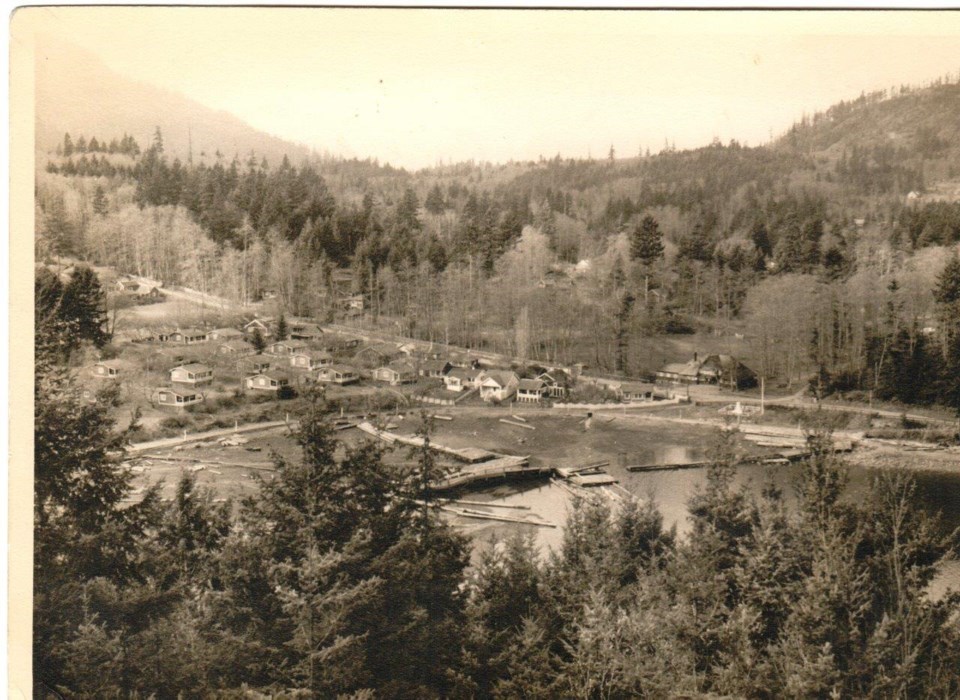In 1920, the Union Steamship Company (also known as Union Steamships, USSCo. and the Union) bought a seaside resort on Bowen Island.
This wasn't the beginning of Bowen's tourism industry, nor was the company's demise the end, but it was certainly the start of an era that would shape the island for the century to come.
Starting 20 years earlier, Captain John Cates had built a thriving tourism and freight business and had made "the name Bowen Island synonymous with the picnic excursion," wrote historian Irene Howard. Even during the First World War, day-trippers, campers, weekenders frequented the Terminal Inn, picnic grounds or dance pavilion.
But it was USSCo. that transformed Bowen into a legendary destination – the Happy Isle.
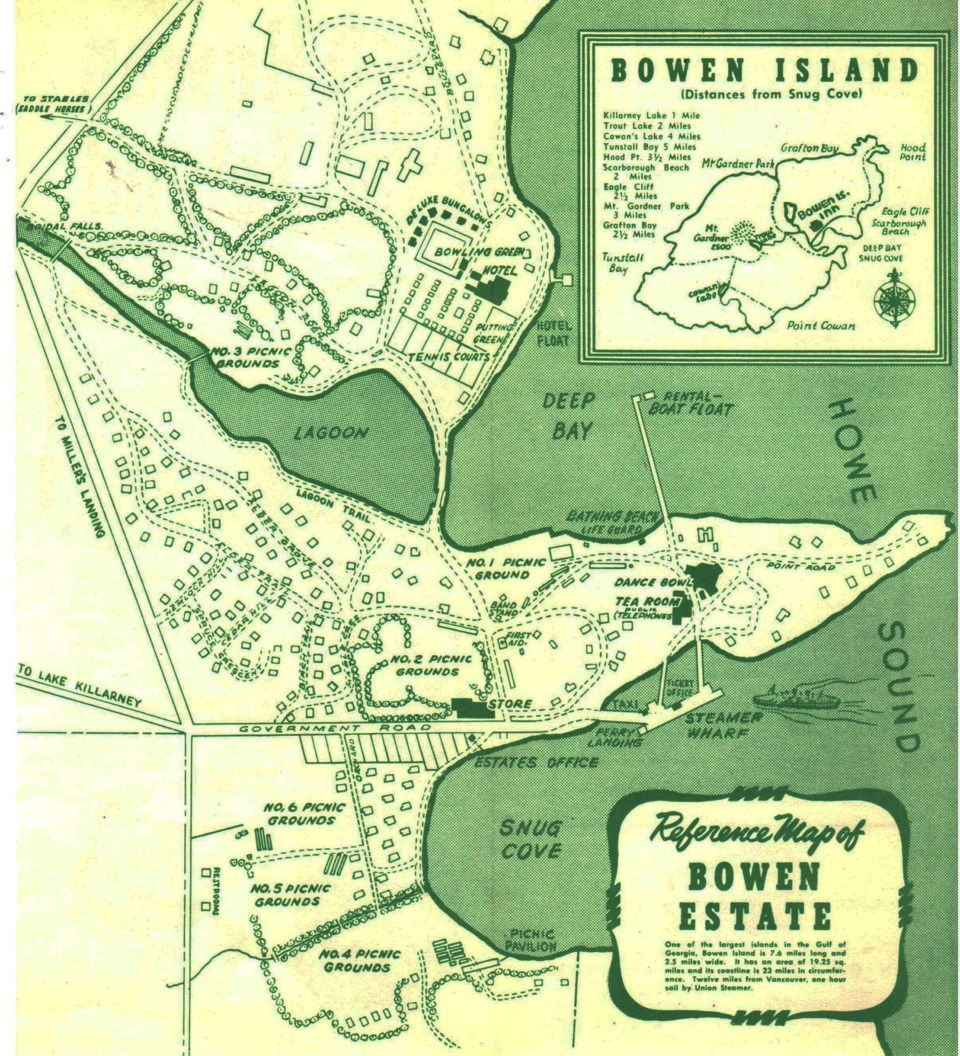 The USSCo. property in its heyday covered all of Snug Cove and Deep Bay, and included a hotel, a dance pavilion, a couple hundred cottages, six picnic grounds and much, much more. (Photo: Bowen Island Museum and Archives)
The USSCo. property in its heyday covered all of Snug Cove and Deep Bay, and included a hotel, a dance pavilion, a couple hundred cottages, six picnic grounds and much, much more. (Photo: Bowen Island Museum and Archives)The Union (as it was known) built the largest dance hall in the province, expanded the picnic areas and the hotel and built the dozens of cottages that once dotted its expansive west side property. Thousands visited Bowen annually, peaking in 1946 with 101,000 people.
Many came aboard USSCo.'s flagship, the Lady Alexandra (seen in the video below).
Islanders Bruce Russell and Murray Atherton frequented Bowen in the late Union years and recall fondly the Bowen of their childhoods.
The antics at the lodge’s beer parlour were something to behold for the unique manner in which the company was able to serve patrons that far exceeded the seating capacity. It was not uncommon to see dozens of thirsty customers, who could not find seating in the pub, sitting on the lawn outside the exit door in the southwest corner of pub. An endless supply of beer served to patrons at the table closest to the door was shared with friends on the lawn outside. Obviously liquor laws were more lax in those days.
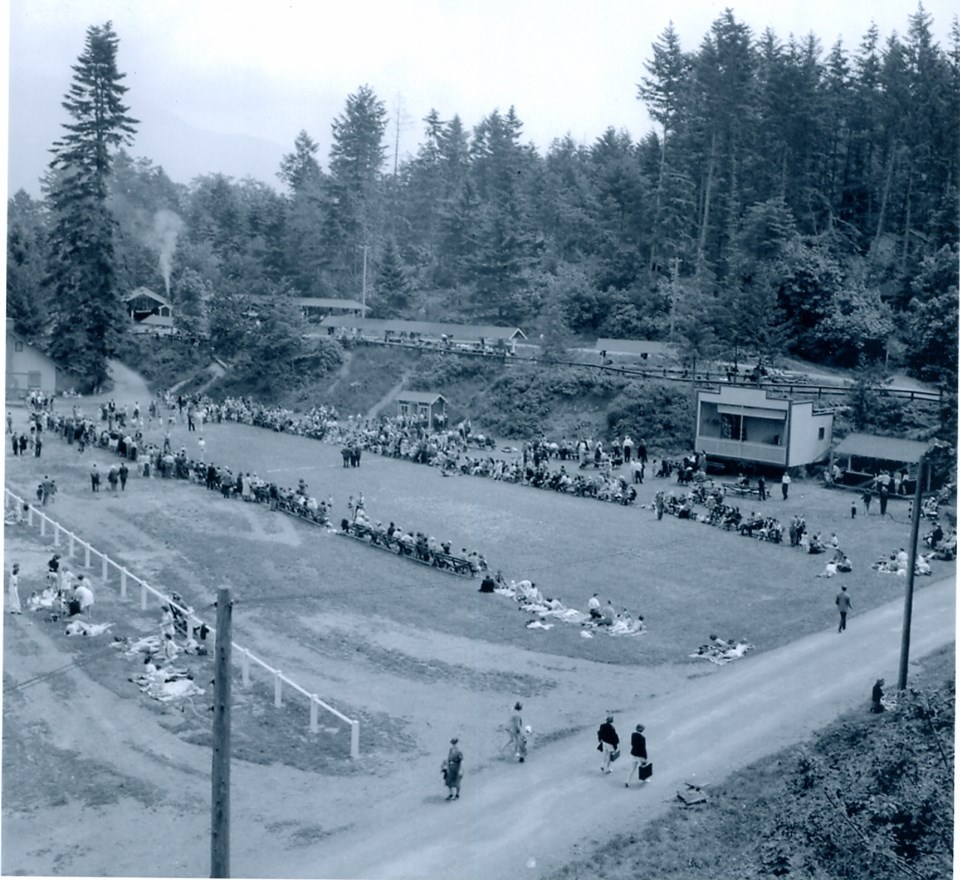 Picnic ground #1 at the entrance to Snug Point was one of six USSCo. picnic grounds. (Photo: Bowen Island Museum and Archives)
Picnic ground #1 at the entrance to Snug Point was one of six USSCo. picnic grounds. (Photo: Bowen Island Museum and Archives)But the Union wasn't just in the tourism business, it was a critical lifeline for communities up and down the coast, as Bowen Island Museum and Archives' Cathy Bayly explains.
Most of the USSCo vessels used for servicing logging camps and pioneer settlements were small, rough steamships. They had to be large enough to cross the Queen Charlotte Sound and small enough to squeeze into the canneries and logging sites. One such vessel was the wooden-hulled Cassiar, outfitted for transporting the loggers between Vancouver and camps. On this ship loggers were allowed to wear caulk boots onboard, and even to bed. It was equipped with an onboard bar and jail. The rules of conduct for this loggers ship included that stewards were not to be pitched overboard.
Captain John Malcolmson worked aboard USSCo. vessels for decades. Duncan MacLeod of the Vancouver Maritime Museum chatted with his now elderly daughter.
During the First World War, Malcolmson remained in Vancouver and in the ’20s and ’30s he was promoted to first mate and captain of USSCo. vessels. While working one of the northern runs he told his daughter about a practical joke his crew played on him. Since there was no onboard running water his crew had given him some warm water to mix up with his shaving soap to create a lather. He worked and worked but try as he might, a lather would not form. As it turned out the crew had given him salt water.
READ: Memories from the steamships: a COVID conversation with the daughter of Capt. John Malcolmson
In the 1950s, the popularity of the Bowen resort was waning. USSCo. tried to rebrand as a luxury destination – Evergreen Estates – but that proved ultimately unsuccessful. In the dying years of the resort, Les Wallwork (father to Helen Wallwork) worked as the Sannie Transportation Company manager for a time (the Sannies were the ferries of the day) and wrote for the company newsletter, 'the Heaving Line.'
If you, dear reader, should ever have to tear yourself away from your warm fireside on a bitterly cold night at approximately midnight, stumble along a draughty wharf, down a slippery gangway and onto a small ferryboat in order to warm up the engine for half an hour so so, how would you feel if, on pitching your cigarette butt out of the boat’s window into the sea, the damn thing stayed there in the inky blackness winking at you like a single bloodshot optic.
READ: A taste of the era: USSCo.'s newsletter – 'the Heaving Line'
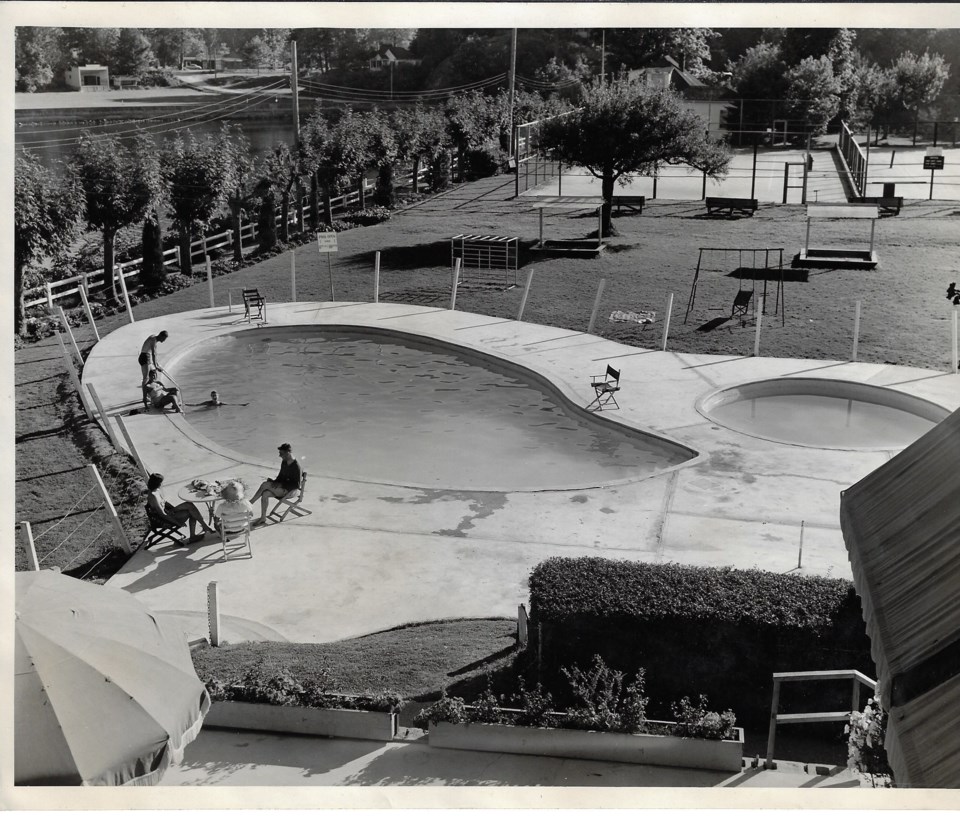 The Union tried to get into the luxury tourism business in the mid-1950s (pool and tennis courts of the refurbished resort seen above) as visitor numbers declined. USSCo.'s actions alienated many islanders, including the felling of a beloved monkey puzzle tree and reducing public amenities. It was in this era that the relationship between residents and the company soured, particularly when it came to ferry service (over which the Union had a monopoly). (Photo: Bowen Island Museum and Archives)
The Union tried to get into the luxury tourism business in the mid-1950s (pool and tennis courts of the refurbished resort seen above) as visitor numbers declined. USSCo.'s actions alienated many islanders, including the felling of a beloved monkey puzzle tree and reducing public amenities. It was in this era that the relationship between residents and the company soured, particularly when it came to ferry service (over which the Union had a monopoly). (Photo: Bowen Island Museum and Archives)The resort's hotel closed in 1957, about the time the Union gave up its ferry monopoly to the island and Black Ball Ferries introduced Bowen's first car ferry (ferry troubles and complaints were a theme, even back in the 1940s and '50s). USSCo. cabin rentals continued for some time.
H.C. Behm and his family didn't arrive to Bowen until the resort had fizzled out but the island still bore the buildings, the people, even the pipe systems, of the once great business.
I had never seen anything like it. The main line from Terminal Creek consisted of a 12-inch “wood stave” pipe, strips of cedar held together tightly by wire. After several decades of use it showed signs of wear and started to leak. Cy’s self-help-method was to jam cedar shingles into the leaking cracks, until the pipe looked like a porcupine. (If anyone has pictures, please publish them).
READ: After the holidayers: the Union’s lasting legacy in Deep Bay & the Cove
Over the years, bits and pieces of USSCo.'s Bowen estate were sold off. In 1983, the regional district, what's now Metro Vancouver, bought the bulk of USSCo. estate for parkland, taking on as well the Union cottages and, in many cases, their tenants. A couple of years ago, Metro Vancouver tore down four of the few remaining cottages in Davies Orchard, to much local controversy, and is now working on a revitalisation plan (Metro is looking at digging into the Davies Orchard project in 2024).
The revitalization is slated to include orchard expansion, interpretive displays, a cottage-themed picnic shelter, a nature experience program area, a nature trail, open space with views of both the marina and coast mountains and improvements to the six remaining cottages.
In the mid-1980s, the Dike family came to Bowen and resurrected the Union Steamship Company name, too transforming the Cove.
If you think of the Union Steam Ship Company Marina today, you picture a historic looking building perched regally beside a resplendent flower garden and grassy lawn where dogs and families frolic. A wooden boardwalk connects you to the orchard cottages and Crippen Park. Walk down the gangplank to the floating marina office, and there are up to 150 boats gently rocking in the ferry wake.
That’s not the scene that greeted the Dikes.
Here's what Snug Cove looked like before and after the Dikes built their own island destination. (Photos: courtesy of the Dikes).
Last year, Sechelt's Clayton family acquired the M.V. Lady Rose, the last operational USSCo. vessel. Though the Lady Rose wasn't known for frequenting Bowen, in 1953 it ran on Sunday and holiday evenings between the Cove and Horseshoe Bay.
Described as a “saucy little lady” by writer Norman Hacking, Lady Rose carried a maximum of 130 passengers and 25 tons of cargo on short day trips through the waters of West Howe Sound.
The ship also carries with it some supernatural history, too...
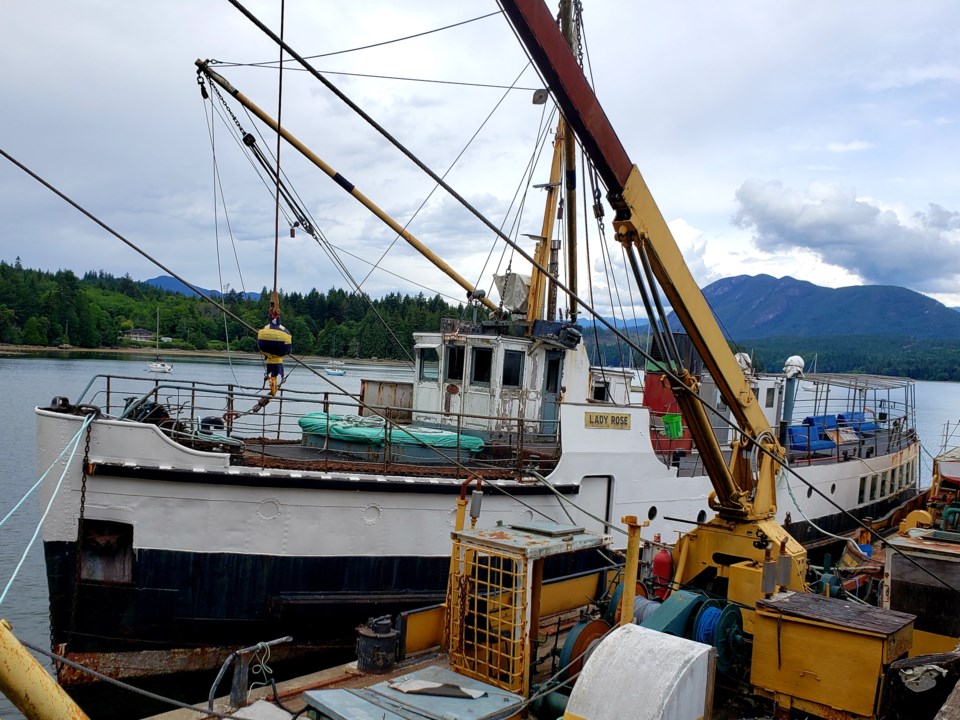 The last operational vessel of the Union Steamships Company fleet, the 200-ton MV Lady Rose, made the journey from Tofino to Sechelt last year as a Sunshine Coast family purchased the historic vessel. Launched in 1937 in Glasgow, the vessel served west Howe Sound and could carry a maximum of 130 passengers and 25 tons of cargo. The Union sold the ship in 1951 but as the last boat standing, it remains a key artifact in USSCo. history. Plans for the boat’s future and resoration are still in preliminary stages. (Photo: James Shaw)
The last operational vessel of the Union Steamships Company fleet, the 200-ton MV Lady Rose, made the journey from Tofino to Sechelt last year as a Sunshine Coast family purchased the historic vessel. Launched in 1937 in Glasgow, the vessel served west Howe Sound and could carry a maximum of 130 passengers and 25 tons of cargo. The Union sold the ship in 1951 but as the last boat standing, it remains a key artifact in USSCo. history. Plans for the boat’s future and resoration are still in preliminary stages. (Photo: James Shaw)
A hundred years later, the legacy of USSCo. still shapes the story of Bowen Island. Undercurrent editor Bronwyn Beairsto looks at the romanticisation of Bowen Island.
READ: EDITORIAL: The story of Bowen Island is under a romantic influence
Had this been any other year, the hundredth anniversary of the relationship between USSCo. & Bowen Island would've prompted community celebrations (and this is a community that loves to celebrate). Helen Wallwork reflects on the anniversary celebrations that weren't.
This year the Bowen Island Heritage Preservation Association (BIHPA) board was looking forward to hosting an old time picnic, author weekends, artist gatherings and a host of events to celebrate the Island as it once was but as we all know the world came to a standstill in March and we had to put all our plans on hold.
The remnants of USSCo. and other Bowen history are still part of Deep Bay and the Cove. One can take the Heritage Trail walking tour and imagine the Bowen of years past.
Explore the USSCo. timeline:
What are your memories of or thoughts on USSCo.? Let us know.
Edition credits:
Concept - H.C. Behm
Coordination - Helen Wallwork
Photos & historical support - Bowen Island Museum and Archives (Catherine Bayly)
Resources:
Bowen Island 1872-1972 by Irene Howard (Bowen Island Historians)
Bowen Island Reflections by Edythe Anstey Hanen, Jim Kearney and Barbara Murray (Bowen Island Historians)
Bowen Island Passenger Ferries: The Sannie Transportation Company 1921-1956 by Peter D. Ommundsen
Arrivals and Departures: the ferries and the people of Horseshoe Bay by Francis Mansbridge (West Vancouver Historical Society)
Echoes of the Whistle: An illustrated history fo the Union Steamship Company by Gerald Rushton
Vancouver's playground: Leisure and sociability on Bowen Isalnd, 1902-57 by Jack Little
2018 Vancouver Historical Society talk ‘In the metropolitan shadow: Bowen Island' by Jack Little
"Bowen Island: A Long History of Welcoming Visitors" by Jody Lorenz (2020 Bowen Island Phone Book)
